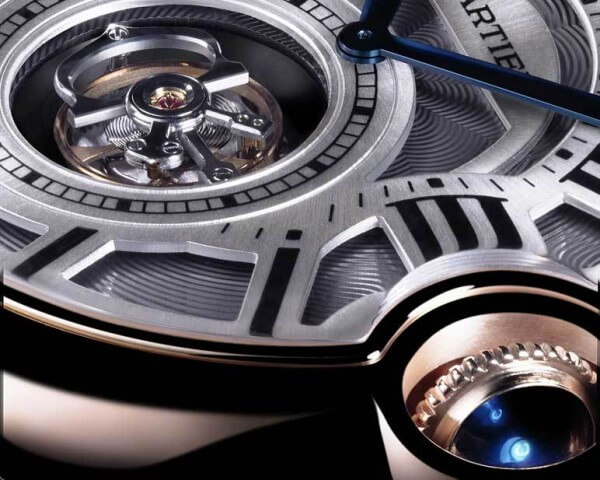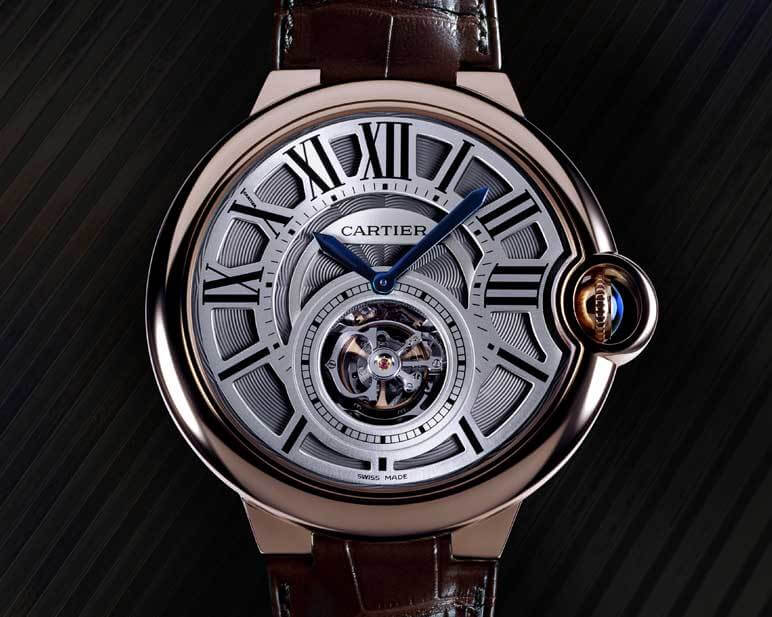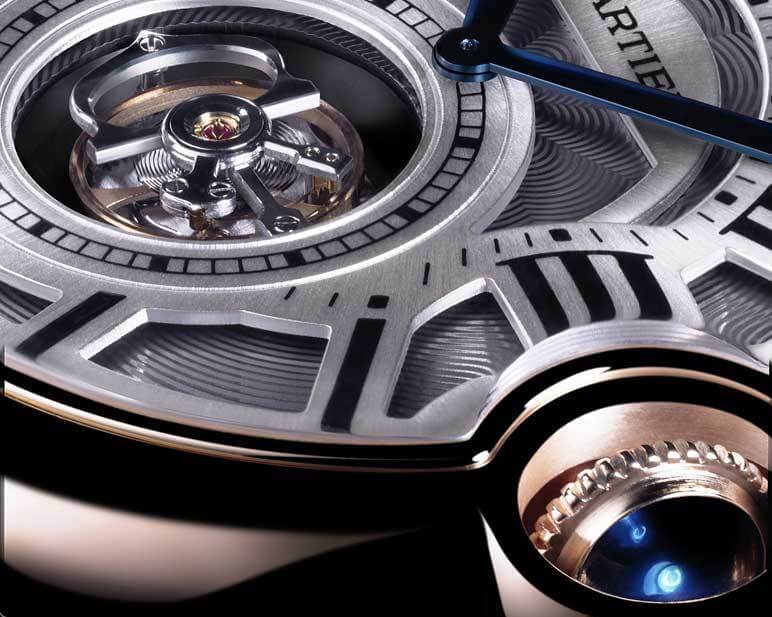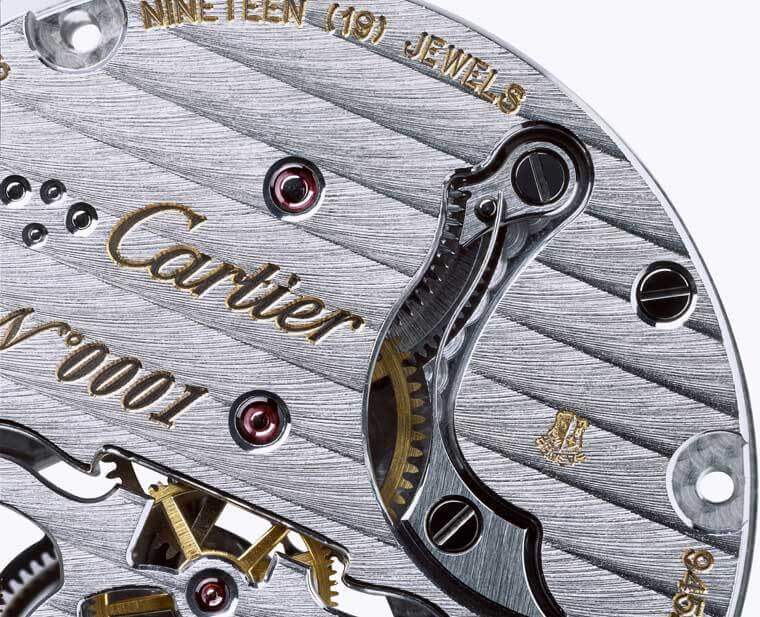Cartier already played one masterstroke last year with the creation of Ballon Bleu, a timepiece whose design is so clearly associated with the brand that even a neophyte could immediately recognise its origins. Now the company, established in Geneva since 1981, has struck again with a Flying Tourbillon in the same collection. The Calibre 9452 MC that equips this new model is stamped with the Poinçon de Genève, marking Cartier’s first steps in the very select circle of manufacturers that can lay claim to this distinction.
“Cartier was busy developing Fine Watch products and the alliance between the Manufacture Genevoise de Haute Horlogerie (MGHH) and the Richemont group was the perfect opportunity to develop this Poinçon de Genève movement in collaboration with its teams,” explains Hélène Poulit-Duquesne, watch marketing development director for Cartier. “All the development work was carried out in Meyrin, with the Manufacture Genevoise de Haute Horlogerie and its staff. However, the movements are assembled in a workshop that has been set aside for Cartier at the Manufacture. For Cartier, this awarding of the Poinçon de Genève represents an important step forward in traditional Fine Watchmaking, the most refined and prestigious of all.”
We have built a powerful reputation in the world of watchmaking for the creation of beautiful and original watches.
Three conditions to be awarded the Poinçon de Genève
In September 2007, Roger Dubuis’ industrial facilities, also known as the Manufacture Genevoise de Haute Horlogerie, became part of the Richemont Group. Speaking earlier in the year, Bernard Fornas, CEO of Cartier International, observed that “we have built a powerful reputation in the world of watchmaking for the creation of beautiful and original watches. In the very near future, Cartier should further distinguish itself in Fine Watches. A large part of the former Roger Dubuis Manufacture, acquired by Richemont, will be reserved for Cartier. This industrial resource will enable us to strengthen our position in the complications watch segment.” Thanks to the Ballon Bleu Flying Tourbillon with its Calibre 9452 MC, available as a limited edition this autumn, this promise has been kept.
As Cartier points out, the Poinçon de Genève is awarded under three essential conditions. The movement must be mechanical and at a minimum have been assembled and adjusted in the canton of Geneva. Each movement must meet with twelve technical and aesthetic criteria. These are outlined in the regulations and have a bearing on the movement’s design and characteristics, and on the quality of manufacturing and finish (see box). Finally, the movement must be approved by the Bureau de Contrôle Facultatif des Montres de l’Etat de Genève (the office of voluntary inspection of watches from Geneva). This Bureau comes under the authority of a sworn commission whose members are appointed by the government of the canton of Geneva. One can easily understand, given these conditions, why so few manufacturers boast the Poinçon de Genève on their movements. Roger Dubuis was one and Cartier can now benefit from its experience.

A watch for connoisseurs
The result, in the form of the Calibre 9452 MC, is a hand-wound mechanical movement composed of 142 parts and 19 jewels. It has a diameter of 10¾'” and is 4.5mm high. It is driven by a flying tourbillon and has a C-shaped index to indicate the seconds. It beats at 21,600 vibrations per hour and has a 50-hour power reserve. As the Poinçon de Genève demands, Cartier has paid particular attention to the finish of the steel parts and jewels. The balance-spring is pinned in a grooved plate with a stud having a rounded collar and cap. This makes it possible to centre the balance-spring more accurately and therefore better adjust the movement. The escapement wheel has been made as light as possible to reduce the impact of its inertia when adjusting the movement. This first Poinçon de Genève movement confirms Cartier’s determination to further strengthen its position in the men’s watch segment by appealing to connoisseurs of Fine Watches.
The twelve criteria for the poinçon de Genève
- The workmanship of all the parts of the movement, including additional mechanisms, must meet the requirements of the Bureau de Contrôle Facultatif des Montres de Genève (office of voluntary inspection of watches from Geneva). Steel parts must have polished angles and drawn flanks and their visible surfaces smoothed. Screw heads must be polished with chamfered slots and rims.
- The gear train and escapement must be jewelled with polished sinks. Jewels on the bridge side must be half-frosted with polished sinks. The centre-wheel jewel on the main plate is not required.
- The balance-spring must be pinned in a grooved plate with a stud having a rounded collar and cap. Mobile studs are permitted.
- Split or fitted indexes are authorised with a holding system. In the case of extra-thin calibres, a holding system is not required.
- Regulating systems with a balance with a radius of variable gyration are authorised provided they meet the conditions of article 3, paragraph 1.
- The wheels must be chamfered above and below and have polished sinks. For wheels that are 0.15 mm or less thick, there can be only one angle, on the bridge side.
- The shanks and surface of the pinions must be polished.
- The escape wheel must be light and not more than 0.16 mm thick in large movements and 0.13 mm in movements under 18 mm. Its locking-faces must be polished.
- The angle traversed by the pallet lever must be limited by fixed banking walls and not by pins or studs.
- Shock-protected movements are accepted.
- The ratchet and crown wheel must be finished in accordance with registered models.
- Wire springs are not acceptable.

















